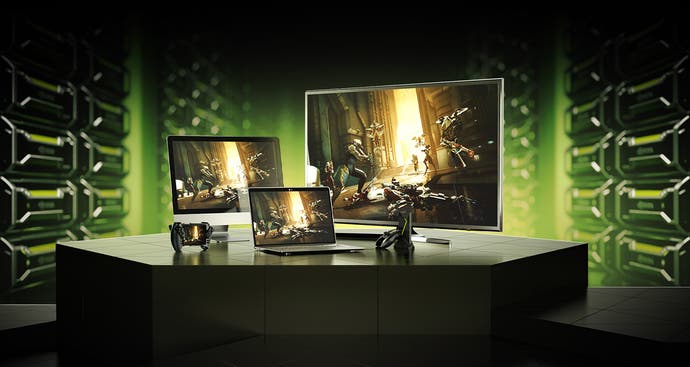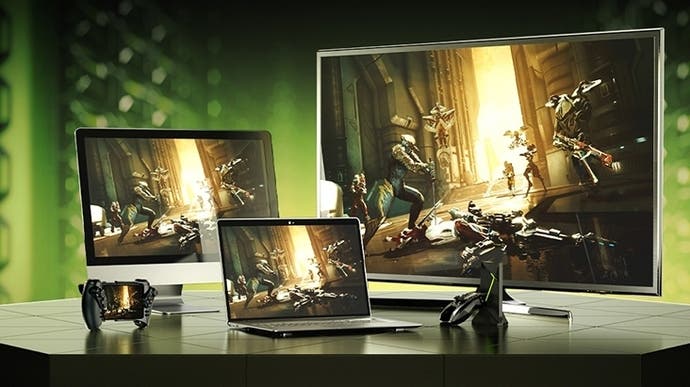Has GeForce Now quietly killed Google Stadia?
Free access for all, play your existing PC games library, low-cost sub for RTX ray tracing.
After years in development, Nvidia's GeForce Now service is finally available to all users. Hosting PC games in the cloud, GeForce Now ties into your existing PC library across a range of online storefronts, allowing you to play your games on computers, smartphones and tablets. 1080p gaming at 60 frames per second is the aim, with Nvidia even offering access to real-time hardware-accelerated ray tracing for users prepared to pay a small price premium. More power, more titles, more flexibility, portability with your games library - in theory it's an impressive offering and 4K streaming apart, its feature set leaves Google Stadia in the shade.
GeForce Now previously ran on a beta basis, with users required to sign up and wait for access to the system. This delay on using the service has now been lifted, with Nvidia offering two access tiers to the system. Most likely to draw attention is the free offering where users can access the cloud system for a session of up to one hour - good enough for a game of Fortnite (apparently the most popular game). After that, there's nothing stopping the user from starting another session, though if the servers are fully occupied, a wait may be required.
Then there's the Founder's Edition tier. Priced at £4.99/€5.49/$4.99 per month for the first 12 months - with the first three months free - Founders get to jump the queue for server availability and can also access hardware-accelerated ray tracing features in supported games. Nvidia says that Founders get access to RTX 2080-level performance and to put it to the test, I loaded up Metro Exodus. At 1080p resolution with all settings fully maxed out, including ultra-level RTX, the game ran flawlessly at 60fps on the demanding Taiga stage.
It's titles like Metro Exodus where the comparisons with Stadia are perhaps the most stark. 4A Games' latest gets a reasonable port to the Google streaming service - it's essentially on par in terms of features with the Xbox One X version, but with some performance issues. However, it's locked to 4K resolution at 30 frames per second, with the full 4K output only available to those with high bandwidth connections. While resolution may be limited to 1080p on GeForce Now, running the game at 60fps with enhanced physics, tessellation and stunning real-time ray traced global illumination is an altogether different, preferable experience. The fact that I had instant access to the game without having to buy it again (as I owned it already on PC) is an obvious advantage, as is the fact that Epic Game Store cloud saves automatically kicked in, meaning I could pick up right where I left off.

There are other aspects of GeForce Now I also find very interesting. First of all, there's more transparency in the client - there's the ability to choose between 30fps and 60fps streaming, several configurations that balance image quality and bandwidth and even a custom feature to tailor the encoding stream more closely to the capabilities of your connection. Discord integration and support for the GeForce overlay are also built in. Nvidia is essentially pitching this is as a cloud rendition of one of its higher end GeForce GPUs.
Compared to Stadia, there's also more transparency in terms of the hardware performance you're accessing - there's nothing stopping you loading up a game with a benchmark that identifies system components. Doom 2016's performance options told me that it was running on a Tesla P40 GPU - pretty much the top-end Pascal card with 24GB of RAM (!). Meanwhile, the ray-tracing enabled Wolfenstein Youngblood ran on a newer Tesla T10 with 16GB of memory. Nvidia tells me that with the RTX-enabled games, you get the full GPU to yourself but for less demanding games, the capabilities of the hardware may be split between two or even four users.
Based on first impressions (and to stress, we'll be taking a much closer look at this soon), GeForce Now looks like a strong offering. The prices are very reasonable, the performance level looks impressive and the fact that it works in tandem with your existing PC games ensures that even if the service is one day deactivated, you don't lose your library. The fact it costs nothing to try out is the icing on the cake - with that in mind, it'll certainly be interesting to see how the servers cope when the floodgates open.

While there are plenty of positives, it's important to balance these with the drawbacks too. First of all, while supporting multiple stores is a good thing, the UI isn't especially clear on which version of the game you're looking to add to the cloud library - I tried to install Far Cry 5, but ended up grabbing the Steam version instead of the uPlay version I actually own. Secondly, while the list of supported games is truly vast, not every title you own may be streamable. Can it run Crysis? Definitely, in theory, at least. However, Crytek's classic trilogy is owned by EA and it looks like none of its Origin titles are available - and even the Steam-hosted EA offerings are a no-show. Similarly, right now, my Square-Enix games aren't available to stream either. From the looks of things, storefronts that are supported include Steam, uPlay, the Epic Games Store and battle.net - not a bad bunch, but not quite the complete line-up. Other issues? Well, I was surprised at how long Metro Exodus took to load.
With all of this in mind, it would be remiss of us not to point out GeForce Now does not exist in a vacuum and that there are other options. Blade's Shadow for example, effectively delivers a PC desktop to use as you will - and not just for gaming. 4K60 and even 1080p144 streaming options are supported and RTX 2080 and Titan RTX-based offerings are in the pipeline. Looking at the firm's 2020 upgrades line-up, the specs look impressive - but the extra flexibility clearly comes with a big price premium over GeForce Now's initial pricing structure. For its part, Nvidia tells me that 4K streaming is entirely viable and may be deployed when the time is right - and to be fair, I've seen demos to that effect in the past along with high frame-rate support.
Regardless, the emergence of GeForce Now from beta is potentially very exciting - not least because a cloud-based system with an impressive feature set is now available to try on your PC, Mac, Android phone or tablet with zero financial outlay or user-side risk required. By extension, its success will inevitably be defined by the quality of its service. After the somewhat variable response to Stadia and with Project xCloud still in beta, perhaps this is the kind of move required by one of the major players in order to reboot the idea of cloud gaming as a viable platform. GeForce Now is available to play today and we'll be taking a more forensic look at what it offers in upcoming Digital Foundry coverage.

